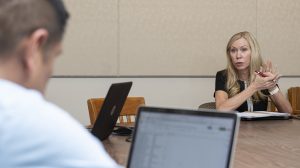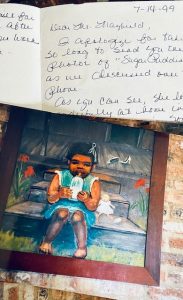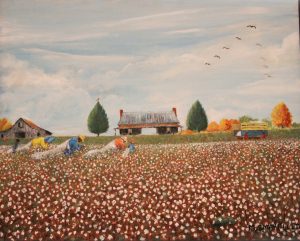
Robrecus Toles, a doctoral student in history, catalogs materials related to acclaimed folk artist M.B. Mayfield. Toles and other Ole Miss researchers are helping prepare Mayfield’s papers and personal effects for display at a new museum and cultural center that will showcase his work in Ecru. Photo by Logan Kirkland/Ole Miss Digital Imaging Services
OXFORD, Miss. – Tucked away in a broom closet within a University of Mississippi classroom, M.B. Mayfield earned a fine arts education in the 1950s the only way he could at the time.
A folk artist, the Ecru native was not able to register at UM because he was barred by the state’s Jim Crow laws. He was hired as a janitor at the university in 1949, when art department chair Stuart Purser discovered his artwork while driving through Ecru. The sympathetic professor secreted him in a broom closet, where Mayfield could keep the door ajar, set up his easel and work in tandem with the other students.
Decades later, university historians are partnering with members of the Ecru community to shine a light on Mayfield’s story and showcase the breadth of his work.
“M.B. Mayfield’s superpower was his imagination, his ability to see beauty in the everyday, to see the expansiveness of the human condition in the crevices of rural Mississippi,” said Brian Foster, a former UM assistant professor of sociology and Southern studies who worked on the project.
“That same imagination helped Mayfield navigate Oxford and the University of Mississippi during a time – the late 1940s and early 1950s – when neither place welcomed Black folks freely. Not only did Mayfield survive that reality, he made ways to make life and art in the midst of it.”
Mayfield became one of the leading folk artists of the 20th century. His work hangs in many galleries all across the nation, and the university has several of his paintings in the University Museum collection.
Gloria High, a longtime friend of Mayfield, and Jeannie Thompson, an archivist and school librarian who recently was elected as an Ecru alderman, began campaigning to save Mayfield’s deteriorating home in late 2019. They presented businessman Ken Nowlin with the idea of restoring Mayfield’s residence as a historic house and museum.

A plastic bin of photographs, papers and other personal effects of M.B. Mayfield awaits sorting and cataloging by UM researchers. Photo by Logan Kirkland/Ole Miss Digital Imaging Services
They soon established a working relationship. Nowlin purchased the home and moved it from its original location to downtown Ecru, along the Tanglefoot Trail.
When the university’s M Partner initiative, a signature program of the McLean Institute for Public Service and Community Engagement, began working in Ecru in fall 2020, the Mayfield project quickly became a focal point for community-campus collaboration.
With the archival support of Thompson and the university, the Nowlin family is restoring Mayfield’s Ecru home and turning it into a museum and cultural center that will include his work and personal effects.
During the spring 2021 semester, faculty from the UM School of Law’s Transactional Law Clinic, the School of Journalism and New Media‘s integrated marketing communications program and the departments of Southern Studies and Sociology and Anthropology worked closely with community leaders to establish the museum as a legal entity, conduct oral history interviews with people who knew Mayfield and develop a marketing campaign to promote the museum.

Jeannie Thompson, supervising archivist from Ecru, discusses research related to M.B. Mayfield with a team of graduate researchers from the UM history department. Photo by Logan Kirkland/Ole Miss Digital Imaging Services
The Arch Dalrymple III Department of History has been building upon those efforts this summer and fall.
Thompson, who has completed postgraduate training in archival work at both Ole Miss and the University of Southern Mississippi, has gotten advice on starting a house museum from scratch from several professional organizations, including the Association of African American Museums.
She is working with four UM doctoral students in history to create an inventory of Mayfield’s possessions, both personal and professional, including correspondence, magazines, financial papers, old exhibition posters, manuscripts, artwork and even cassette tapes.
They are meticulously sorting through thousands of artifacts, the first step in cataloging them.
“We started the processing with listing items to create an inventory and are completing first-level preservation efforts,” said Thompson, who is spearheading the processing effort. “After the graduate students completed the inventory listings, we developed series headings and drafted the finding aid for the collection.
“These efforts will guide future researchers in using these materials. The graduate students’ input on researchable topics within Mayfield’s papers have been extremely helpful as I am designing exhibits and interpretative spaces in the future Mayfield House Museum.”
The painstaking work is being conducted by graduate students and Thompson in two offices in Bishop Hall on the Ole Miss campus. It is an opportunity for them to broaden their skills and spectrum of experience.
The students are Monica Campbell, from Jonesboro, Arkansas; Paul Mora, of Clovis, California; Chuck Savage, of Little Rock, Arkansas; and Robrecus Toles, of Oxford.

Monica Campbell, a doctoral student in history, goes through sketches and other materials belonging to folk artist M.B. Mayfield. Photo by Logan Kirkland/Ole Miss Digital Imaging Services
“We have an evolving public history program, including a new course we’ll be offering in spring 2022,” said Noell Wilson, chair of the history department. “It’s important to give history graduate students as many choices as possible for future careers.”
Toles is starting the doctoral program in history this fall.
“One of the manuscripts I handled was an unpublished short story by Mayfield called ‘Peace Be Still,’ which he wrote in the early 2000s,” he said. “The story describes how he lost his father and half his siblings to tuberculosis and then he contracted the disease himself.
“He recovered but with his father and siblings gone, the brunt of the work of running the family fell on him. That consumed his teenage years.”

A photograph of one of M.B. Mayfield’s paintings and a thank you note from the buyer are part of the Nowlin family’s colelction that is part of the new museum in Ecru. Photo by Jeannie Thompson
The sorting process is “very meticulous,” Toles said.
“I also know that working with archives, you have to choose what makes it into the archive out of all the personal documents, correspondence, manuscripts and art,” he said. “You’re choosing which things will make it into the museum one day. It’s a big responsibility.”
With the initial inventory completed, Thompson hopes to have all Mayfield’s personal papers arranged by December so the team can start putting together exhibits and interpretive materials. The tentative target for opening the museum is summer 2022.
“I hope to continue to partner with the university as we complete the work and open the museum,” she said. “I would really like to see a formal partnership for service learning where we would have a graduate assistant who would work as a paid intern and get experience in running a house museum.
“This could be a tremendous opportunity both for the museum and the university to offer real-world experience and to develop this museum into a cultural center for the community.”

